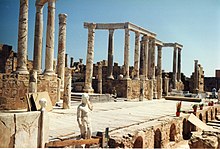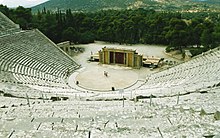425:
475:
17:
450:
400:
500:
161:
also served as another "hidden stage". At times some of the action went on inside, in which case it was up to the audience to decide what was happening based on the noises coming from the inside. It was a convention of the dramas of the classic period that characters never died on stage, instead
64:
means 'tent' or 'hut', and it is thought that the original structure for these purposes was a tent or light building of wood and was a temporary structure. It was initially a very light structure or just cloth hanging from a rope, but over the course of time the
192:
in 31 BC. As
Ancient Greece began to change from a culture consisting of ethnic and city-state Greeks to one governed by large monarchies, theatre architecture to include the stage buildings began to experience significant changes. In the 4th century BC, the
199:
became a permanent stone structure and the stage was raised off the ground. In surviving examples this stage seems to have been raised by 2.5–4 m above the orchestra, and to have been 2–4 m deep, terminated by the
237:('god-speaking'), from which one might assume that its primary use was for the advent of deities, either at the start or close of the drama." Most theatres still standing today date from the Hellenistic period.
171:
At some point at Athens in the
Classical period a small stoa colonnade was constructed behind the scene-building with its back to the theatre and would have provided a permanent backdrop for the action."
313:
no longer supported painted sets in the Greek manner, but relied for effect on elaborate permanent architectural decoration and consisted of a series of complex stone buildings. To each side there was a
213:
declined in importance compared to a smaller group of main actors, the chorus remained in the orchestra to perform, while the main actors generally performed from the stage on top of the
225:
itself became increasingly elaborate, and was also available as a place for actors to declaim from, so that the performers between them had three levels available. "The roof of the
69:
underwent fundamental changes. First, it became a permanent building, whose roof could sometimes be used to make speeches, and as time passed it was raised up from the level of the
293:
with three or more doors, and sometimes three stories. The evolution of the actor, who assumed an individual part and answered to the chorus (the word for
350:
facade remained normally outside the view of the audience, and fulfilled the original function as a changing room and place for props.
605:
151:
behind the orchestra – where the performers acted, played, and danced – broke what is thought to have been the original
649:
273:
was as elaborate as its Roman development, which dispensed with the orchestra altogether, leaving a relatively low
590:"Grove" = Anastasia N. Dinsmoor, William B. Dinsmoor jr, "Architecture; Theatres" section in Thomas Braun, et al.
104:
had become a large and complex, elaborately decorated, stone building on several levels. Actors emerged from the
139:
in Athens is thought to have been the first purpose-built theatre. Around the middle of the 5th century BC, the
634:
584:
70:
110:
and could use its steps and balconies to speak from. It was also where costumes were stored and to which the
572:
644:
639:
591:
219:. This important change occurred in the Hellenistic period, between the 3rd and 1st centuries BC. The
246:
124:
45:
261:') is the term for the elaborately decorated stone screens, rising two or three stories, that the
303:, means 'answerer'), introduced into drama a new form, the alternation of acted scenes, or
152:
128:
424:
8:
185:
136:
135:. Early Greek theatres were simple open air structures built on the slope of a hill. The
181:
598:
580:
474:
127:
began in the 6th century BC and traces its origins to religious rituals such as the
189:
55:
619:
628:
251:
91:
was behind the orchestra and provided a space for supporting stage scenery.
39:
30:
16:
210:
95:
449:
399:
276:
499:
132:
112:
332:, which might be deepened to give a third stage level, seen through
304:
106:
25:
21:
345:
339:
333:
327:
321:
315:
308:
298:
268:
262:
256:
232:
226:
220:
214:
201:
194:
188:'s death in 323 BC and lasted until the Roman Victory at the
163:
156:
146:
140:
99:
86:
80:
74:
59:
116:(painted panels serving as the background) were connected.
626:
549:. Malden, MA: Blackwell Publishing. p. 39.
601:, Oxford University Press. Web. 22 Mar. 2016.
281:facade, often decorated, and a wide stage or
620:http://www.crystalinks.com/rometheaters.html
145:began to appear in Greek theatre. Placing a
288:
282:
274:
267:had now become. By the 1st century BC, the
498:
473:
448:
423:
398:
20:The stage of the South Roman theatre in
15:
627:
544:
353:
175:
131:and choral odes to the gods known as
540:
538:
577:The Oxford History of Classical Art
119:
54:was the structure at the back of a
28:; the structure at the back is the
13:
338:or openings. The interior of the
14:
661:
612:
535:
287:behind, ending in an elaborate
240:
553:
547:A Guide to Ancient Greek Drama
526:
517:
1:
566:
155:nature of Greek theatre. The
346:
340:
334:
328:
322:
316:
309:
299:
269:
263:
257:
233:
227:
221:
215:
202:
195:
164:
162:usually retreating into the
157:
147:
141:
100:
87:
81:
79:, or "space in front of the
75:
60:
7:
606:Perseus Encyclopedia, Skene
326:was the upper floor of the
184:started around the time of
10:
666:
37:
46:theatre of ancient Greece
618:Ancient Roman Theatre -
510:
344:('building') behind the
650:Greek words and phrases
595:(subscription required)
503:
478:
453:
428:
403:
289:
283:
275:
85:". The facade of the
35:
635:Ancient Greek theatre
502:
477:
452:
427:
402:
125:Ancient Greek theatre
19:
597:. Grove Art Online,
545:Storey, Ian (2005).
412:Nova Trajana Bostra
153:theatre in the round
129:Festival of Dionysus
186:Alexander the Great
137:Theatre of Dionysus
645:History of theatre
640:Parts of a theatre
504:
479:
454:
429:
404:
354:Surviving examples
182:Hellenistic period
176:Hellenistic period
36:
599:Oxford Art Online
592:"Greece, ancient"
508:
507:
657:
596:
560:
557:
551:
550:
542:
533:
530:
524:
521:
387:Emerita Augusta
358:
357:
349:
343:
337:
331:
325:
319:
312:
302:
292:
286:
280:
272:
266:
260:
255:('facade of the
236:
230:
224:
218:
205:
198:
190:Battle of Actium
167:
160:
150:
144:
120:Classical Greece
103:
90:
84:
78:
63:
665:
664:
660:
659:
658:
656:
655:
654:
625:
624:
615:
594:
569:
564:
563:
558:
554:
543:
536:
531:
527:
522:
518:
513:
356:
243:
231:was called the
178:
122:
42:
12:
11:
5:
663:
653:
652:
647:
642:
637:
623:
622:
614:
613:External links
611:
610:
609:
602:
588:
573:Boardman, John
568:
565:
562:
561:
552:
534:
525:
523:Broadman, 168.
515:
514:
512:
509:
506:
505:
496:
494:
491:
488:
485:
481:
480:
471:
469:
466:
463:
460:
456:
455:
446:
444:
441:
438:
435:
431:
430:
421:
419:
416:
413:
410:
406:
405:
396:
394:
391:
388:
385:
381:
380:
377:
371:
368:
365:
362:
355:
352:
247:Roman theatres
242:
239:
177:
174:
121:
118:
9:
6:
4:
3:
2:
662:
651:
648:
646:
643:
641:
638:
636:
633:
632:
630:
621:
617:
616:
607:
603:
600:
593:
589:
586:
582:
579:, 1993, OUP,
578:
574:
571:
570:
556:
548:
541:
539:
529:
520:
516:
501:
497:
495:
492:
489:
486:
483:
482:
476:
472:
470:
467:
464:
462:Leptis Magna
461:
458:
457:
451:
447:
445:
442:
439:
436:
433:
432:
426:
422:
420:
417:
414:
411:
408:
407:
401:
397:
395:
392:
389:
386:
383:
382:
378:
376:
372:
369:
366:
364:Ancient city
363:
360:
359:
351:
348:
342:
336:
330:
324:
318:
311:
306:
301:
296:
291:
290:scaenae frons
285:
279:
278:
271:
265:
259:
254:
253:
252:scaenae frons
248:
238:
235:
229:
223:
217:
212:
207:
204:
197:
191:
187:
183:
173:
169:
166:
159:
154:
149:
143:
138:
134:
130:
126:
117:
115:
114:
109:
108:
102:
97:
92:
89:
83:
77:
73:, creating a
72:
68:
62:
57:
53:
52:
47:
41:
40:Scaenae frons
33:
32:
31:scaenae frons
27:
23:
18:
576:
555:
546:
528:
519:
484:Hellenistic
434:Hellenistic
379:Photographs
374:
367:Modern city
294:
250:
244:
241:Roman period
211:Greek chorus
208:
179:
170:
123:
111:
105:
96:Roman Period
93:
66:
50:
49:
43:
29:
604:"Perseus",
375:references
317:paraskenion
94:During the
58:. The word
629:Categories
585:0198143869
567:References
487:Epidaurus
323:episkenion
300:hypokrites
277:proscenium
234:theologian
216:proskenion
168:to do so.
133:dithyrambs
88:proskenion
76:proskenion
38:See also:
335:thyromata
113:periaktoi
71:orchestra
532:Perseus.
490:Argolis
370:Country
305:episodes
284:pulpitum
493:Greece
443:Greece
440:Athens
437:Athens
390:Mérida
373:Notes,
361:Period
341:logeion
320:. The
209:As the
107:parodoi
44:In the
583:
559:Grove.
468:Libya
465:Khoms
459:Roman
418:Syria
415:Bosra
409:Roman
393:Spain
384:Roman
307:. The
98:, the
48:, the
26:Jordan
22:Jerash
575:ed.,
511:Notes
347:skene
329:skene
310:skene
295:actor
270:skene
264:skene
258:skene
228:skene
222:skene
203:skene
196:skene
165:skene
158:skene
148:skene
142:skene
101:skene
82:skene
67:skene
61:skene
56:stage
51:skene
581:ISBN
180:The
245:In
206:.
631::
537:^
297:,
249:,
24:,
608:.
587:.
34:.
Text is available under the Creative Commons Attribution-ShareAlike License. Additional terms may apply.





